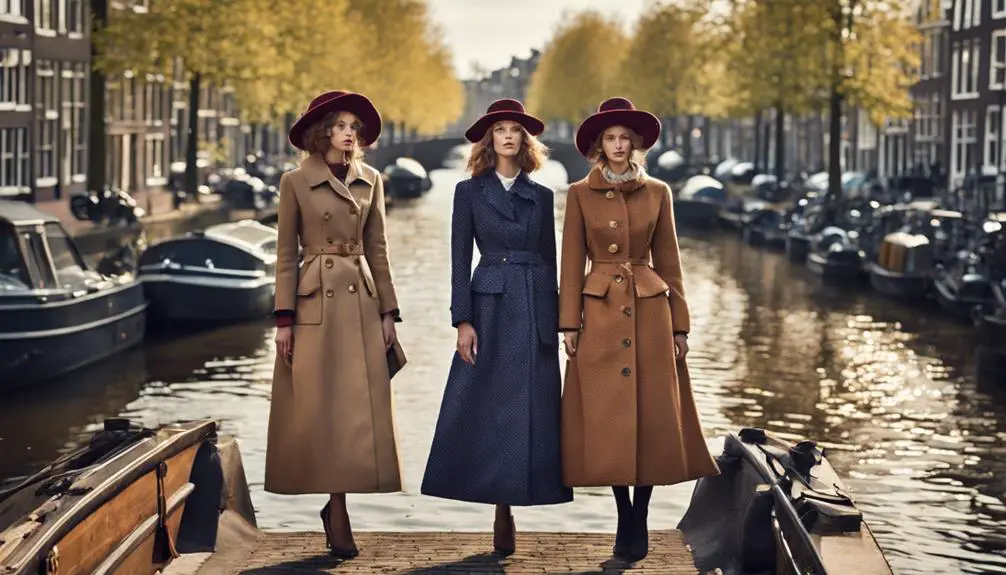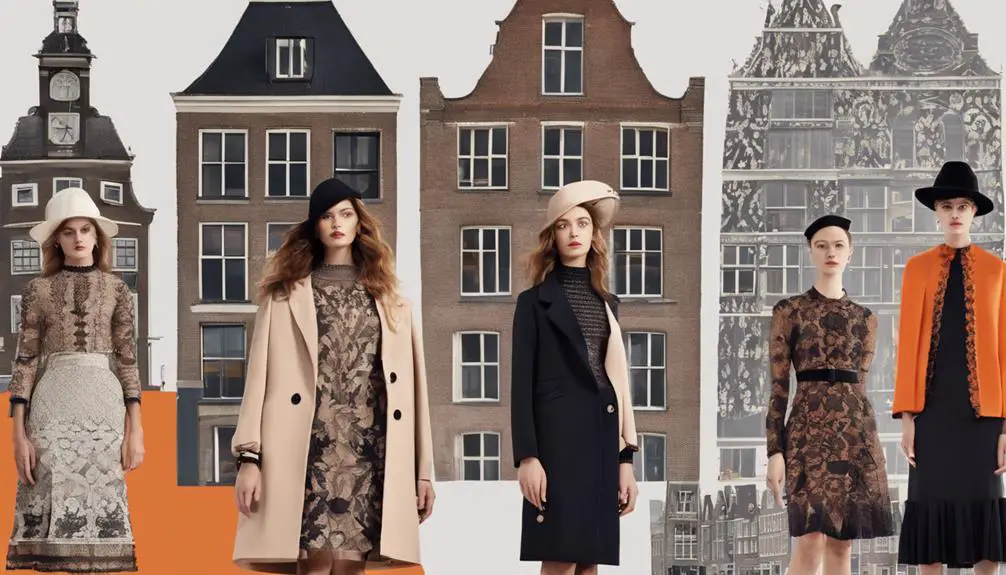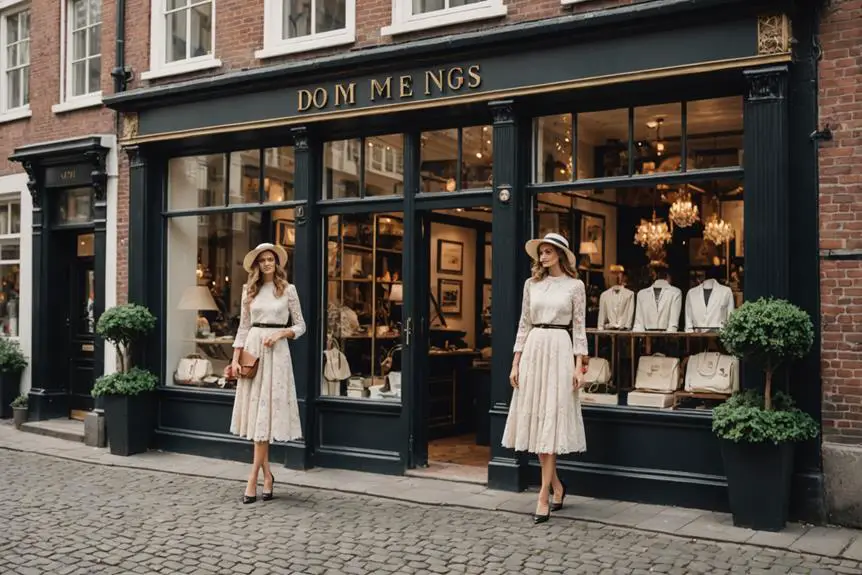If you're curious about the oldest Dutch fashion brands, search no more! Iconic names like Hema, founded in 1926, set the standard for affordable chic, while others like Scotch & Soda since 1985 and G-Star RAW since 1989 have pushed creative boundaries with eclectic designs and luxurious denim, respectively. These brands emphasize craftsmanship and sustainability, merging traditional techniques with modern aesthetics. They've left a significant mark on global fashion trends, looking to blend authenticity with innovation. With such a rich heritage, there's so much more to discover about these fabulous Dutch labels and their unique stories!
Historical Overview of Dutch Fashion Brands

The history of Dutch fashion brands showcases a vibrant evolution that reflects the country's unique cultural influences and entrepreneurial spirit. Emerging in the 1980s, brands like Scotch & Soda quickly became known for their high-quality, stylish clothing that appealed to men, women, and children alike. This pioneering spirit paved the way for G-Star RAW, founded in 1989, which revolutionized the fashion industry with its luxury denim and innovative use of raw, untreated materials. You can see how these brands shaped the landscape of Dutch fashion, focusing on creativity and sustainability in their clothing.
In the early 2000s, the scene transformed once more with the rise of Patta. Originally a boutique, Patta evolved into a powerhouse in streetwear, collaborating with various artists and influencing urban fashion culture. Similarly, Sissy Boy, established in the 1980s, carved a niche by blending women's clothing with home decor, appealing to a diverse consumer base that values both style and functionality.
Suit Supply, founded in 2000, challenged the norms by offering affordable yet upscale suits, making tailored fashion accessible. Throughout these decades, Dutch fashion brands have consistently showcased high quality and innovative designs, reflecting a commitment to sustainable clothing practices. Each brand adds its unique flair to the fashion industry, helping to establish the Netherlands as a hub for creativity and style. This exciting journey through Dutch fashion history reveals a landscape rich with innovation and artistry, making it a thrilling domain to explore.
Iconic Brands and Their Legacy
Dutch fashion brands have carved out a significant space in the global market, each leaving a lasting legacy that continues to influence contemporary style. Brands like Scotch & Soda, founded in 1985, showcase the beauty of eclectic designs, offering quality products that celebrate Dutch lifestyle and heritage. Their unique approach to high fashion has made them a staple for those seeking individuality in their wardrobe.
G-Star RAW, established in 1989, stands out for its innovative raw denim designs, which not only redefine style but also promote sustainable fashion practices. This commitment to environmentally friendly production has influenced countless other brands and consumers alike, showing that style and sustainability can go hand in hand.
Sissy Boy, launching in the 1980s, has evolved to deliver a vibrant range of women's clothing and home decor, becoming a beloved brand in the Netherlands. Their focus on lively aesthetics attracts a diverse clientele, proving that iconic brands can adapt and thrive.
Patta, which began as a small boutique in 2004, now leads the streetwear scene with collaborative designs that resonate with urban culture. This evolution highlights the dynamic nature of Dutch brands.
Don't forget Hema, established in 1926, known for offering affordable, stylish clothing and essential household goods, particularly clothes for kids. Hema embodies Dutch practicality and design, ensuring that quality products remain accessible to all. Each of these iconic brands contributes uniquely to the rich tapestry of Dutch fashion, inspiring future generations.
Evolution of Style and Design

Tracing the evolution of style and design in the Netherlands reveals a rich history that blends tradition with innovation. Beginning in the 1920s, Joan Praetorius set a high standard for Dutch fashion with her elegant designs for royalty, showcasing the quality that would become a hallmark of Dutch brands. As you investigate the landscape of Dutch clothing brands, you'll notice the distinctive identity that emerged in the post-war era. Designers like Max Heymans and Frank Govers played pivotal roles in shaping this identity during the 1960s, laying the groundwork for future evolution.
The 1970s marked a turning point with Fong Leng, whose original designs gained international recognition, pushing Dutch fashion into the global spotlight. As you probe deeper, you'll see how the 1980s ushered in a new wave of creativity, with Koos van den Akker achieving fame on prestigious platforms like New York fashion shows, demonstrating the potential of Dutch designers on a grand scale.
Then came the 1990s, a decade characterized by conceptual brilliance, exemplified by Viktor & Rolf. Their innovative and theatrical presentations not only captivated audiences but also solidified the Netherlands' reputation as a powerhouse in the fashion industry. This evolution reflects a dynamic interplay of creativity and craftsmanship, showcasing how Dutch designers continuously redefine style and design while maintaining a commitment to quality. As you explore this journey, you can appreciate how the past informs the present and inspires future generations in the world of fashion.
Impact on Global Fashion Trends
Numerous iconic Dutch fashion brands have profoundly influenced global fashion trends, showcasing the country's creativity and craftsmanship. Take G-Star RAW, for example; founded in 1893, it revolutionized the luxury denim market by promoting raw, untreated denim as a must-have style choice. This daring approach not only captured attention but also set the standard for high fashion brands worldwide, much like how vintage Adidas logos signify cultural impact and quality.
Then there's Scotch & Soda, established in 1985. Known for its high-quality and stylish clothing, this brand consistently marries classic and contemporary styles, pushing boundaries and inspiring trends that resonate globally. Its ability to blend various aesthetics has made it a favorite among fashion enthusiasts, further solidifying the Netherlands' presence in the international style scene.
Similarly, Sissy Boy emerged in the 1980s with its playful, colorful designs that effortlessly merge Dutch aesthetics with mainstream appeal. The brand has influenced countless others, proving that a unique vision can capture a wide audience.
On the streetwear front, Patta began as a boutique in 2004 and quickly made waves in global fashion culture through its innovative collaborations and graphic designs. This brand has redefined urban fashion, highlighting the importance of community and creativity.
Together, these brands underscore how Dutch designers set trends that not only resonate with local markets but also make significant impacts on global fashion trends, emphasizing quality, creativity, and a distinct point of view.
Significance of Craftsmanship in Fashion

Craftsmanship plays an essential role in fashion, especially within the vibrant landscape of Dutch design. When you immerse yourself in the world of Dutch fashion, you'll quickly notice an emphasis on authentic craftsmanship that brings traditional techniques to life in modern, innovative ways. This celebration of heritage shines through in brands like KASSL Editions, which crafts durable outerwear inspired by the functionality of traditional fishermen's coats. Each piece is not just clothing; it tells a story of quality and resilience.
Applied Art Forms takes this craftsmanship further, showcasing how meticulous garment construction can create unique fashion pieces that stand out in a crowded market. When you wear items from these brands, you're choosing tailored designs that reflect a deep commitment to both craftsmanship and sustainable practices. This focus guarantees that your wardrobe not only looks good but also aligns with values that matter today.
As you explore the evolution of Dutch fashion, you'll find that this craftsmanship narrative is pivotal. It blends innovative design with respect for traditional methods, creating a compelling appeal for contemporary consumers like you. With each stitch and seam, these brands remind us that fashion isn't just about trends; it's about creating lasting pieces that resonate with authenticity and quality. In a world increasingly driven by fast fashion, embracing craftsmanship allows you to make choices that are both stylish and meaningful. So, when you choose Dutch fashion, you're not just wearing clothing; you're supporting a legacy of artistry and ethical practices.
Frequently Asked Questions
What Is the Oldest Famous Fashion Brand?
The oldest famous fashion brand showcases heritage preservation through iconic designers' creativity. Its brand evolution embraces cultural influences, sustainable practices, and global expansion, reflecting a rich history while adapting to modern consumer demands.
What Is the Most Popular Clothing Brand in the Netherlands?
When you explore the Netherlands' fashion scene, you'll find Dutch streetwear brands thriving alongside sustainable fashion. Fashion influencers spotlight local designers, while fashion events and online shopping make popular choices easily accessible for you.
What Is the History of Fashion in the Netherlands?
You'll discover that Dutch fashion's history blends textile innovations, royal influences, and traditional costumes. As you explore, you'll see historical garment evolution leading to contemporary trends and a growing focus on sustainable fashion practices.
What Is the Fashion Capital of the Netherlands?
Amsterdam's like a vibrant canvas, showcasing Dutch fashion's evolution. You'll find streetwear blending with sustainable designers, heritage textiles, and local artisans during Dutch Fashion Weeks, all influenced by modern trends. Explore this dynamic fashion capital!




